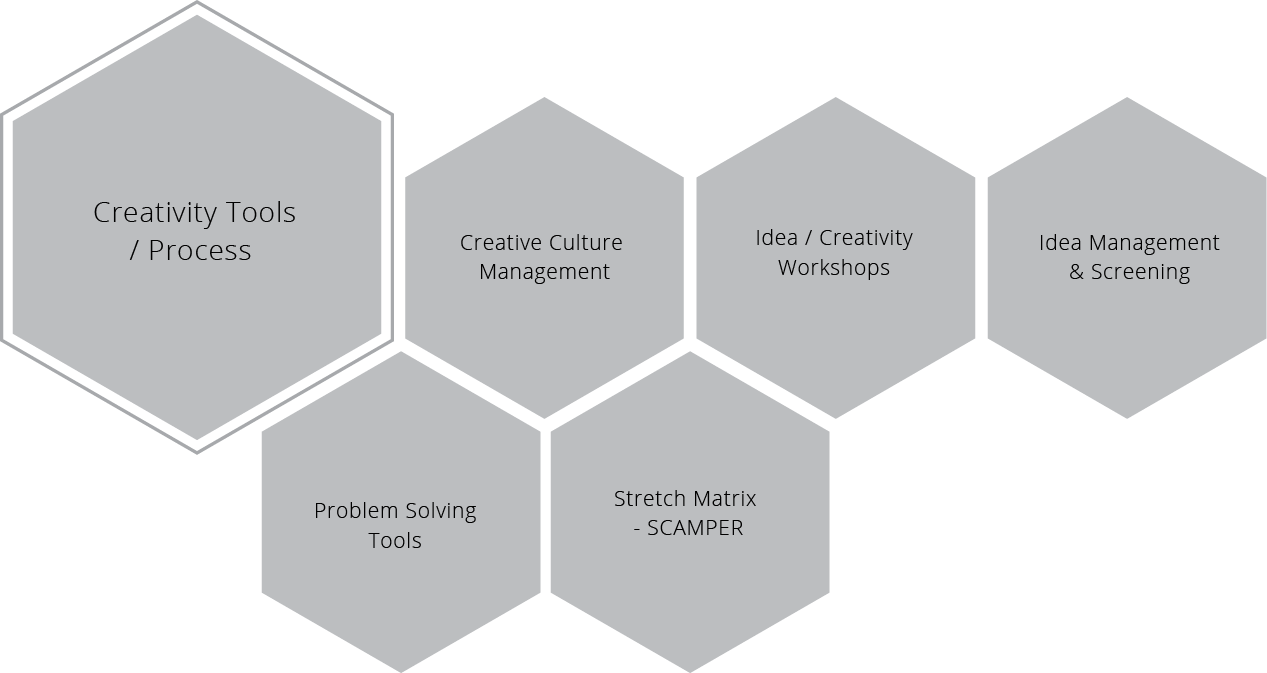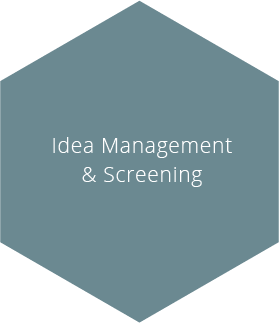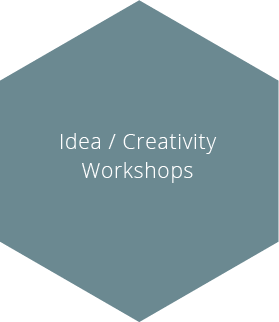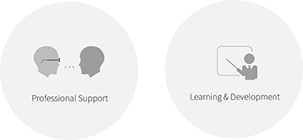Glossary
Logout
©Copyright Arcturus 2022, All Rights Reserved.
7
Terms & Conditions
|
|
|
|
Security & Privacy
Contact
CREATIVE CULTURE MANAGEMENT
|Introduction
The development of a creative culture as a style of working will help any group or team achieve higher levels of creativity, innovation and problem solving and provide a structure for their own continuous improvement in quality, creativity and performance.
The first stage is to establish a cultural environment by carrying out an assessment of the existing team culture, identifying its strengths and weakness and taking the necessary action if improvements are needed. This can be achieved either by carrying out a full Seven Attributes Cultural Assessment as described elsewhere and/or by the shorter route of using the exercise on Cultural Similarities as a workshop.
For special project teams that do not normally work together or for newly formed work groups that have not yet established a consistent work culture the above exercises will be a useful introduction to cultural team working. They will enable the group/team members establish norms of working together that will carry through to the project.
This particular workshop exercise is designed as an introduction to the Basic Rules and Methods of working as groups or teams in a creative culture. It takes the group right through the process of live ‘creative action’ resulting in a significant contribution to an understanding of motivation.
Although a specific subject is chosen in this instance as part of the Seminar programme, the methodology provides a template for further training, practice in creativity or for actual real live problem solving, innovative and continuous improvement programmes.
Recall that motivation is ‘what causes us to move, to act, to arrive at decisions’. It is that which moves us to act in certain ways by the desire to achieve external goals, satisfy inner needs or avoid unpleasant or unwanted outcomes.
Motivation itself is derived from external influences and/or from internal beliefs, thoughts, feelings and emotions. Not only is our behaviour and performance affected by our own motivations, the actions and behaviours of other people also affect our performance. Thus we can be positively motivated towards doing something with enthusiasm or to do things in fear or anger, or we can be negatively motivated to avoid doing things which perhaps others would wish us to do but who have ‘put us off’ by their own actions or attitude.
Motivations are thus very complex and we can often only guess at what motivates other people by what we observe of their facial expression, from what they say and, most important, how they behave. We call this ‘attribution’, whereby we attribute to others motives, which may not in fact be correct. In this exercise we will list as many of the causes of motivation that we know from our own personal experience: ‘these are the factors that motivate or de-motivate me’. And ‘these are the motivating and de-motivating factors that I believe affect other people’s behaviour’. In the time available we will suggest and sort into some kind of sensible order as many factors as possible, following the Basic Rules and Method as described below.
The workshop is sectioned under five headings: Process, Basic Rules, Method, Cultural Group Formation, Subject or Purpose. Each section will be discussed or acted upon in turn. The following notes are offered as guidance and for later reference to avoid undue note taking.
The workshop begins by explaining the Process of creativity and innovation from the generation of original creative ideas by individual group members, through the development and selection of the ideas as a group activity to their innovation by practical application.
The second stage is to establish the BASIC RULES for the conduct of the workshop and then to describe the METHOD of creative working that generates, sorts and applies the various thoughts and ideas into coherent, structured and practical suggestions, recommendations and/or solutions to the project or problem in hand.
The fourth stage is Cultural Group Formation. In the case of a permanent or semi-permanent group or team, a Cultural Assessment exercise to produce a Profile, using either the Seven Attributes or the Cultural Similarities questionnaires will introduce the principles of group/team culture that can then be developed into a culture improvement programme as described elsewhere. For this Seminar workshop however, or similar ad hoc training group a rather different method is required to form a temporary cultural group just for this short demonstration session.
An alternative introduction to cultural group formation is a simple Commitment Exercise. A commitment is a resolve to see something through. It is to do our best to make a success of the project. The Commitment Exercise is also a short practical demonstration of the Seven Attributes as an aid to cultural group formation. It can also be used generally as an ‘attitude test’ for any given project. A high negative score will predict failure, as in: ‘we are beaten before we start’. A high positive score will predict success. It affirms the attitude: ‘let’s go for it’, ‘let’s give it our best shot’. The Commitment Exercise thus alerts us to the presence of negative attitudes that may inhibit our ability to make the best contribution we can to the session. The intention is that it will put us in ‘the right frame of mind’ before we start.
The fifth and final stage is the Subject or Purpose of the group creative session.
There is a distinctive sequence of elements that combine to promote the creative process. These are:
a) Idea initiation
Ideas ‘come to mind’ but they can be encouraged and prompted to do so by association with other ideas and with existing knowledge that is then seen in different ways. The aim is to engender an atmosphere that supports and encourages the generation and flow of ideas.
b) Connectedness
Creativity is the connecting of new thoughts and ideas with existing knowledge, or the re-connection of existing knowledge in new ways. Connections between words, thoughts and ideas create a ‘network of meaning’ in the mind. To ‘see the connection’ is to gain a new understanding of what is happening. The aim then is to make connections between ideas generated and the subject in hand.
c) Themes
A theme is a group of ideas that are connected together under a single heading. In music a ‘theme song’ has a memorable tune that we associate with a particular person, play or situation. In a story a theme is the plot that we follow as the story unfolds. In creativity a theme is a subject heading that prompts a flow of thought.
d) Incubation
To incubate is to ‘hold in readiness’. It is a form of quiet preparation as in incubating an egg. Incubation of ideas in the mind is a process of ‘unconscious thinking’ that goes on as for example ‘when we sleep on a problem’.
e) Emergent
Whilst there is not the time in the exercise itself to incubate ideas, it is an important part of creativity to be aware of and to record ideas that ‘emerge from’ and as a result of a theme. This can be done later, perhaps the next day. Emergent order is when ideas come to mind in answer to a problem often when least expected. During the exercise and in future, watch out for emergent ideas because they are often the most valuable.
f) Selection
It is very important to be selective. Brainstorming in particular generates large numbers of ideas that have no connection with each other or with the subject in hand and so are wasted. But a certain amount of ‘unconnectedness’ or redundancy is inevitable in creative thinking by its very nature. However, by a process of selection and watching out for emergent themes, we can make the most of our ‘ideation potential’
g) Verification
To verify is to confirm or prove an idea or suggestion to be true or worthy of further consideration. It is to connect the idea meaningfully with the purpose or objective of the exercise. And so we select those thoughts and ideas that make the most sense and have the best chance of going forward to conversion. With practice we find that verification is a cumulative process so that new ideas will often connect with, verify, substantiate and give new meaning to previous ideas – especially when creating a new theme.
h) Conversion – Innovation
It is very important to distinguish between ‘ideation’, as the formation of ideas in a person’s mind and the conversion of the idea through innovation into real products or processes. The idea is always to do with the individual person, even when sharing ideas. This is because they are ‘mental constructs’ and no one person can ‘see into’ or share the mind of another.
Converting the idea into new and innovative knowledge, products or processes almost invariably requires the active support and co-operation of other people as in the cultural group or team.
i) Test by Practical Application
The acid test of creativity is that new ideas work for us. They need to be productive. They should result in new or improved products or processes, new solutions to existing problems and/or produce new knowledge and meaning.
There is a set of ‘rules’ the adherence to which will maximise the flow of ideas and enhance the quality of our creative thinking. The Commitment Exercise that will start the session will take us through the Seven Attributes to set the stage for a session of creative thinking. The Basic Rules are part of a creative thinking method that we can develop for ourselves as a habitual way of thinking that can be a life-enhancing programme of personal development.
a) Open mind
This is the first rule of ‘attitude’. A closed mind by definition closes to the possibility of new ideas and new possibilities. We need to be ‘open-minded’ which is not to say that we are ‘taken in’ by everything we see or hear. An open mind will actively seek new ways of looking at things, which then have to be examined, verified and tested before acceptance.
b) Status free
We examine ideas and statements on their own merit, free of preconceptions or bias governed by the status of their source. Whilst it is true that an authoritative source by definition is worthy of respect, it does not guarantee the source is invariably right. A creative group is therefore equalitarian, by which we mean that every member is given equal respect and consideration irrespective of her or his status outside the group.
c) No criticism
Constructive criticism is valuable and should be welcomed. But to criticise and/or blame others may hide the true facts of where a fault really lies or what the reality of a situation is. In any event, a session of creative thinking should be non-judgemental and free of criticism, which halts the flow of ideas and is a distraction. A genuine critique on the other hand is invaluable when left until the verification stage.
d) Freewheeling
To freewheel is ‘to move without effort’ or constraint. It is to flow. We can only freewheel downhill however on a smooth road under the influence of gravity. Thus creative freewheeling is to generate ideas under the influence of an enthusiastically creative atmosphere. In writing or speaking free flow is fluency. It is to be articulate without effort. It is to make a subject appear easy and simple to understand. The more work we do beforehand in preparation for a subject or session the easier and more fluent the ideas will flow.
e) Make connections – follow themes – validate selections
As described previously, this is to convert creative thinking into a meaningful, productive and rewarding thought process. It is to channel our thought processes towards the attainment of clear and valued goals. When we are not sure what the end point will be, when we are truly freewheeling without direction, then we watch for ‘emergent order’. A theme or consistency will emerge to channel our thoughts in a particular direction. We can then be selective – ‘is this the direction that we wish to follow?’ If it is then carry on, if not then return to a clear and open mind and begin again.
f) Feed-back results
In any group or teamwork, feedback is an essential ingredient to continuity and progress. Feedback is a form of recognition for the part played by members. It is to put the finishing touches. It is to round off the exercise by letting members know the results – good, bad or inconclusive. Not to give feedback is to take part in a team game or the Lottery without knowing the result! Feedback is important to the generation of further ideas. It is a new starting point on the path of continuous improvement.
g) Review
A review is a more formal inspection or examination of the results of the exercise. It could be a critique from which lessons are learned. A review is an assessment without which an exercise or project will lack completion. Not to conduct a review is like walking out of a theatre, cinema or stadium with friends without commenting on the event or expressing an opinion. A review connects the past to the future. It gives continuity and helps us to draw conclusions about what has happened previously and so arrive at a decision concerning what we should do in future. A review is a learning process. A review can give a poor performance a decent burial – as frequently happens in the world of sport, music and theatre. On the other hand a good review can light up a subject, performance or good idea to bring it to the attention of others.
A method is a systematic way of conducting our affairs. It places the individual rules and operations into an orderly system. The method for this exercise begins with the assembly of the group and ends with a review of the results. To be methodical is to act or behave in a systematic, logical and predictable way so that people know where they stand, how to behave in a particular situation and know what to expect. A methodology is a scientific method. This means that a particular method has been evaluated and approved scientifically. ‘Creative Action’ is a methodology for creativity (ideation and innovation) based on scientific research, analysis of alternative methods and evaluation by practical application.
The elements of a methodical way to approach creative thinking in order to get the best results are listed below.
a) Assemble (diverse) group
The idea of assembling a diverse group of people to form a creative group is that they will each bring to the session a different point of view, a wide range of knowledge and a set of different experiences that will create new connections. Revans was a great believer in group diversity in Action Learning, a methodology he developed as a physicist in the Cavendish Laboratory in the 1930’s and which has made an important contribution to our own methodology. (See also d. and j. below).
b) Facilitate rather than leadership
A facilitator will encourage ideas through coaxing and coaching whereas a leader will tend to impose her or his ideas on the rest of the group thus restricting their input. The most senior person(s) in the group should ‘take a back seat’ and let the others set the pace – and not react to criticism of (their) leadership! Except perhaps to join in the general hilarity this may cause.
c) Identify topic
The aim is to at least begin the session by focusing on the subject in hand. It is for all the members to have a clear understanding, preferably beforehand, of what the topic is and the purpose of the exercise. Ideally the topic should become a theme from which will emerge related (connected) ideas and suggestions.
d) Gather information
A fundamental principle of creative thinking is thorough preparation. The more knowledge the group has on any particular subject the greater the quality and quantity of ideas that will be generated. An important aspect of Action Learning is to recruit expertise from outside the group from whoever and wherever it may be found.
e) Discuss and analyse
This is the process of concentration. It is to concentrate the minds of group members on the subject but in as wide-ranging and informative way as possible. The more work that can be done in preparation for the session, the more focused and effective will be the creative process and the less time and effort will be wasted during the session on generating irrelevant ideas.
f) Generate ideas
The method for generating ideas has been covered in the previous section but it is worth repeating that a methodical approach to the creative process will be the most rewarding. It is important to differentiate between the method as providing structure and atmosphere within which creativity is enhanced and the strictures of method as an imposed technique, which retards ideation.
g) Clear thematic display
The aim always is to keep topic and purpose in focus. It is to encourage connectedness and themes. Hence the ideas as they are formulated should be recorded in as simple, concise and plain manner as possible and then displayed and grouped together in a methodical (orderly) fashion where they can be clearly seen and understood by everyone present.
h) Defer judgement
Judgement, criticism, blame are all negative responses to ideas that hinder, discourage and prevent free flow. A thoughtful unspoken judgement on the other hand can direct a group member’s thoughts away from a particularly unrewarding or ‘dead-end’ track. It is usually the case however that, by virtue of their unconnectedness on the display, it will be unnecessary for them to be criticised.
i) Synthesise new connections
To synthesise is to combine individual elements into a whole. The aim is to discover new connections that are meaningful, which by definition creates new knowledge. The ‘chemistry’ or atmosphere of the creative session should induce the synthesis of new connections. Note that old ideas combine in new ways produce a synthesis.
j) Selection, Verification and Presentation
It is in the process of selection, verification and presentation that expert knowledge is most required. The excitement of generating new ideas and new syntheses may disguise the fact of their impracticability. The rule in creativity and innovation is that the more disconnected the idea from mainstream normality the higher the cost of innovation, not least in education – as in the need for explanations to the inevitable questions: what is ‘it’? what does ‘it’ do?, how is ‘it’ made?, how much will ‘it’ cost to produce?, who is likely to buy ‘it’? and how much can we can sell ‘it’ for? The innovative improvement to an existing product, process or service is usually less costly to introduce and easier to explain than the brilliant new invention that requires a high investment in faith, finance and resources before it is marketable. The presentation of new ideas to people who are responsible for the bottom line but have not been through the imaginative creative process is the vital part of creativity. The aim is to enlist the aid of a person in authority who will bridge the gap between imagination and reality, who will be the idea’s champion.
k) Reflection
The process of creativity does not begin or end with the creative session. Of at least equal importance to good preparation is ‘time for reflection’. (See also notes on ‘incubation’.) When the mind is stimulated it will continue working often without our awareness that it is doing so. How often for example, have we thought of exactly the right and wittiest thing to say when it is just too late. Or had an answer to a question ‘on the tip of the tongue’ for ages until the answer pops into the mind when we least expect it. Opportunities should be provided for late suggestions, perhaps by means of a second more focused work-through session.
l) Application
The practical application of the idea is the acid test of viability. This is the culmination and justification for the creative culture: ‘does it work?’ ‘Does it make a profit or improve our quality, productivity or service?’ Application is the outcome and the purpose in which success is the final arbiter. A key principle of creativity is that purpose and outcome provide the ultimate incentive for the concentrated preparation that will help ensure a successful outcome. This is a virtuous circle that should also be a cycle of continuous improvement.
m) Feed-back, Evaluation and Review
To give feedback is to keep people informed. To keep people in the dark is not a good way to encourage their creativity. When all is said and done we need to tell all the people concerned what has happened – good, bad or indifferent. This in itself will help us to evaluate and review what actually happened. To evaluate is to assess the final cost and worth of the project. To review is to place the project into a broader setting. It is to set the creative process into the broader framework of the real world. It is also to see how the real world is changed and transformed by creative ideas and innovations.
n) The Creative Culture
The aim always is to develop a team or organisational culture that will be creative and innovative as a normal and conventional way of working. Creativity should be a way of thinking, living and working that becomes the norm. It is to be in free flow in a changing world. It is to go with the flow in a manner that enables us to be in control of our own pace and direction of change. The ultimate aim of the Creative Action methodology is to help create such a culture throughout the organisation by the process of cultural team building in which all work groups have been initiated.
“There can be no learning without action
and no action without learning”
(Revans)
In this workshop we adopt the Revans principles of Action Learning which is to address real issues in a positive and meaningful way so that the exercise will be a valuable learning experience. To achieve this aim we make a commitment to contribute as much as we can in order to gain the maximum benefit.
Commitment Exercise – in Culture group formation
The Commitment Exercise is a simple seven-part questionnaire that measures our individual commitment and attitude towards the workshop. It is scored as if it were a Culture Profile with five points given in response to each question. A full commitment will be scored with five points positive for each question. Anything less than a full commitment will include scores for a mixed positive/negative response. The scores will reflect not only the Commitment of the respondent but also the degree to which the Basic Rules and Method have been explained and their worth perceived. It would also be of interest to see if there has been any change in scores at the end of the exercise from the original.
The Commitment exercise sets the tone for the group by setting out the positive aspects of creativity that are most likely to yield the best results. However the Commitment is confidential to each respondent and is not intended for disclosure to other group members unless there is unanimous agreement to do so beforehand.
|How does motivation affect performance?
|1. The Creative Process
|2. The Basic Rules
|3. Method
|Idea Gen Cultural Group Formation
|Strategic Business Models, Workshop Tools & Professional Resources
PMM - Professional Support
Interactive Business Models
More














